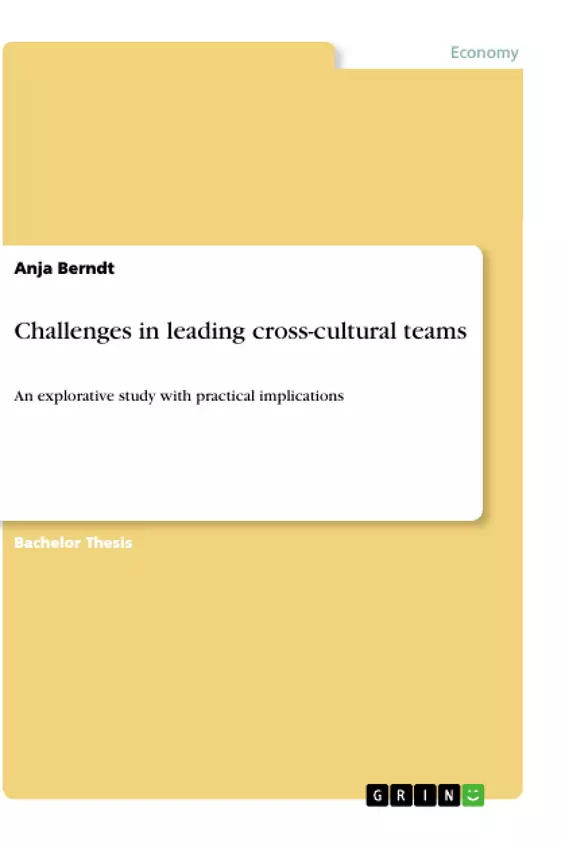Teams are staffed with people from different nations, which brings many advantages in terms of achieving the best possible results for customers, who also have different cultural backgrounds. In this thesis, the leadership challenges that arise and are present in cross-cultural teams will be presented, and practical instruments to deal with them will be indicated.
One element that affects team performance and defines success is leadership. Yet, leaders influence the team outcome. In this complex environment leaders are challenged through these diverse cultures with new issues and requirements. Gaining further practical insights can help to understand, recognize and reduce these issues to ensure the company’s success.
The thesis aims to ascertain the challenges of leading a cross-cultural team, as well as which practical instruments are available to deal with them, by conducting three interviews with experts and providing explanations based on theories. Accordingly, this thesis aims to provide some ideas concerning what leaders can expect that they need to solve and the necessary skills when leading a cross-cultural team.
Based on the literature, analysis questions will be developed for the expert interviews with a leader, an HR developer and an advisor/coach, based on which the challenges will be found.
The subject of this thesis is the leadership of cross-cultural teams and it will focus on the interaction between the leader and team in an organizational environment, e.g. a department or an association for a specific task. Although the specific team variables such as size, composition and gender, virtuality, corporate culture and company structure are not part of this question and will not be considered separately, they nevertheless play a role and thus cannot be ignored.
To answer the research question, culture and cross-cultural teams will first be defined, whereby the cultural frameworks of Hofstede and the GLOBE study and team processes will be described. Subsequently, leadership will be defined and considered. The next chapter will explore the method as defined by the literature and the research procedure employed in this thesis as well as the results will be evaluated and discussed. In the final chapter, a conclusion will be reached highlighting challenges
Inhaltsverzeichnis (Table of Contents)
- Introduction
- Task, objectives, motivation
- Methodical approach
- Structure of work
- Fundamentals of theory
- Culture frameworks
- Definitions
- Culture dimensions of Hofstede
- Culture dimensions of GLOBE
- Evaluation of cultural frameworks
- Cross-cultural teams
- Definition
- Team model and evaluation
- Team development
- Team processes and dynamics
- Problem factors in cross-cultural teamwork
- Leadership
- Definition
- Leadership styles
- Leadership styles according to cultural standards
- Tasks, competences and challenges of leaders
- Summary of theory
- Culture frameworks
- Empirical investigation
- Method of expert interview
- Characterisation
- Advantages and disadvantages
- Structure and design of question guide
- Selection of interviewees
- Conducting interviews and collection of data
- Method of qualitative content analysis
- Characterisation
- Advantages and disadvantages
- Transcription of data
- Procedure of analysis
- Results
- Discussion
- Comparison of interview results
- Comparison of interview results with theory
- Summarising interpretation
- Limitations of investigation
- Method of expert interview
Zielsetzung und Themenschwerpunkte (Objectives and Key Themes)
This work aims to investigate the impact of cultural differences on leadership and teamwork in cross-cultural settings. It focuses on understanding how cultural frameworks, leadership styles, and team dynamics interact within diverse teams. By analyzing the experiences of professionals in cross-cultural collaborations, the study seeks to identify common challenges and potential solutions for effective teamwork and leadership in a globalized context.
- Influence of cultural differences on leadership styles
- Impact of culture on team dynamics and processes
- Challenges and strategies for effective cross-cultural teamwork
- Analysis of theoretical frameworks and empirical evidence regarding cultural differences
- Application of qualitative research methods to understand real-world experiences of cross-cultural collaboration
Zusammenfassung der Kapitel (Chapter Summaries)
The introduction establishes the research objective, methodological approach, and structure of the work. Chapter 2 delves into fundamental theoretical concepts related to culture, cross-cultural teams, and leadership, providing a comprehensive overview of relevant frameworks and models. This chapter includes a discussion of culture dimensions, team dynamics, and various leadership styles, examining their significance in cross-cultural contexts. The empirical investigation section presents the methods employed in the research, focusing on expert interviews and qualitative content analysis. This section describes the research design, participant selection, data collection, and analysis procedures, providing a detailed account of the methodology used. The results section presents the key findings from the interviews, analyzing the challenges and strategies identified by participants in cross-cultural collaborations. Finally, the discussion section compares the interview results with existing theory, offering interpretations and insights into the impact of cultural differences on leadership and teamwork in practice.
Schlüsselwörter (Keywords)
The main keywords and focus topics of this work include: cross-cultural teams, leadership styles, cultural frameworks (Hofstede, GLOBE), team dynamics, challenges, strategies, qualitative research, expert interviews, content analysis, and globalized workplaces.
- Quote paper
- B.A. Anja Berndt (Author), 2020, Challenges in leading cross-cultural teams, Munich, GRIN Verlag, https://www.grin.com/document/980984



